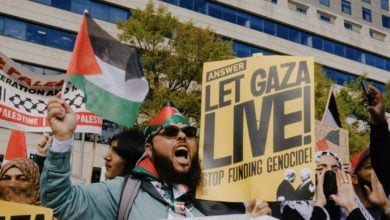On March 11, 1976, the Israeli government declared that it would be appropriating nearly 20,000 Dunams (about 5,000 acres) of land in the Galilee to further expand their colonial project. The state also announced that its robbery would be accompanied by a curfew in six nearby villages, effective at 5 p.m., March 29.
In response, local leaders called for protests and a general strike to occur on March 30. The Israeli government immediately ruled all protests illegal. Under threat of losing their jobs, teachers from the Galilee to the Negev led their students from the classroom to the streets to join in the general strike. Thousands of police officers and soldiers were deployed to the Galilee, and six protesters were killed, some 100 wounded and hundreds arrested for protesting the theft of their land.
Since then, Palestinians have commemorated these events each March 30 as “Land Day.”
Another Land Day
March 30, 2012, saw yet another Land Day. Just as in 1976, there were solidarity protests in the West Bank, Gaza Strip and Lebanon. But in addition, activists from Turkey, Iran, India, Pakistan and the U.K. traveled to Lebanon to participate in the Global March to Jerusalem alongside their Palestinian and Lebanese brothers and sisters. The march never made it past the Lebanese military at Beaufort Castle, several miles from the border.
Just as in 1976, innocent life was lost. Mahmoud Zaqout, 21, was killed as he approached the Gaza-Israel border. Thirty-seven more in Gaza were injured.
In recent years, as the unabashed oppression of the Palestinian people has come into sharper focus, Land Day solidarity actions have taken place globally. Land Day this year saw demonstrations in Jordan, Egypt, Italy, Korea, Canada and Tunisia as well as in London and many U.S. cities.
The entire West Bank was closed off in anticipation of the protests. Authorities closed the Al-Aqsa Mosque to all Palestinian men under the age of 40. IDF forces used tear gas, sound grenades, rubber bullets and a water cannon called the “skunk,” which sprays sewage-smelling water, on protesters throwing stones at the Qalandiya checkpoint near Jerusalem. Thousands of police and IDF troops were deployed in east Jerusalem alone, with thousands of additional troops deployed across the north in preparation for mass demonstrations.
The struggle behind Land Day
The Israeli occupation has displayed extreme brutality since before the country’s official founding in 1948. The line propagated in the corporate media is that this is a quarrel about religion and that Israel is on the defensive. The reality is the opposite. The Zionist project is a colonial one and has been a land grab since the beginning.
For 64 years, the Israeli government has been doing everything in its power to get the Palestinians to give up and leave. For decades, the U.S. has been helping Israel pursue that goal. Most of Israel’s weapons are provided or subsidized by the U.S. government.
The imperialists are not interested in any “peace process” but in maintaining their investments and control of the region’s resources, especially its oil. The colonial-settler state of Israel is the U.S. government’s most precious geopolitical asset in the region. It serves as a watchdog and a permanent military base to keep client states in line and aid in the overthrow of any government attempting to follow an independent course.
Capitalism’s inhumanity has no boundaries, as has been shown time and time again throughout history. But what the imperialist powers always seem to forget is that neither are there boundaries for people’s resistance. The people of Palestine and the people of the world demonstrated that resistance on this Land Day and the 35 before it. We in the belly of the beast will also resist next Land Day and continue to resist with the Palestinian people until Palestine is free.






